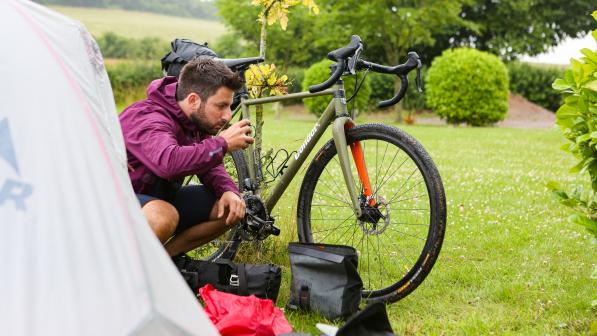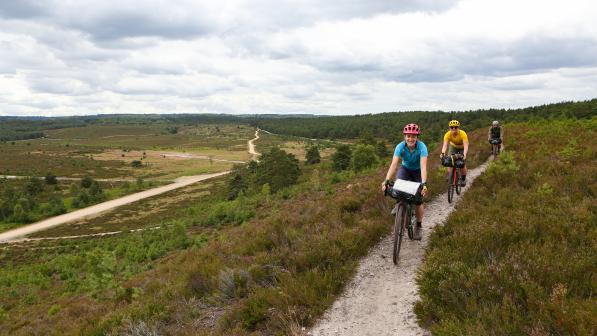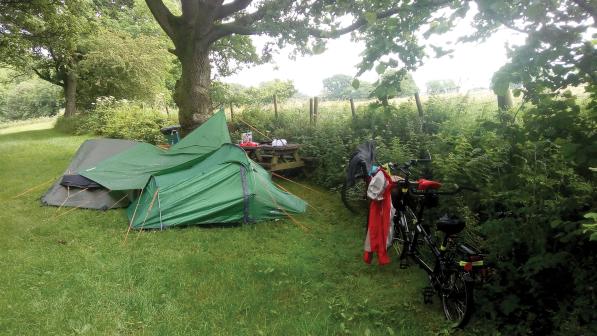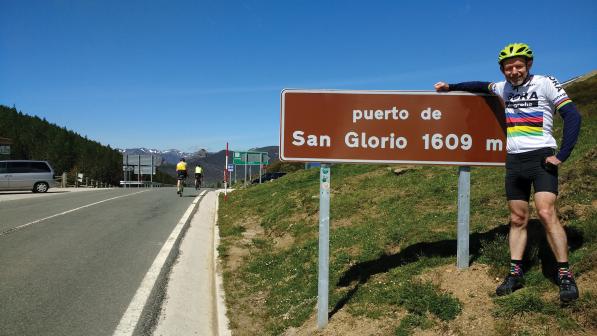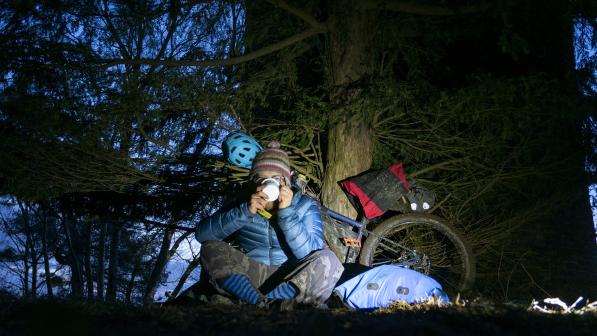A guide to bikepacking

Bikepacking is a relatively recent phenomenon. In a sense, at least. People have been strapping bags to handlebars and donning backpacks since the dawn of mountain biking, and using their knobbly tyred bikes to explore remote routes unreachable on day trips.
What differentiates this new wave of bikepacking is the specialised gear that’s emerged and the popularisation of long-distance mountain biking routes.
The term bikepacking is borrowed from US bike-tourers of the 1970s. Today, bikepacking is perhaps best described as lightweight, multi-day bike touring, largely on dirt roads or singletrack trails. The lightweight element is a response to the demands of riding such terrain. You want the bike to be light enough to enjoy the trails that you can ride, and then heft over technical sections you can’t.
Almost any cross-country mountain bike can make a decent bikepacking machine
Cass Gilbert
Conventional touring favours racks and panniers. And for most road-based trips, these remain perfect for the job. On off-road terrain, racks and panniers add unnecessary extra weight; weight that isn’t tightly distributed across the bike, making for an unwieldy ride.
Instead, soft bags are preferred. Frame-bags are the most obvious: zippered bags that make use of the centralised, low-to-the-ground area that is otherwise wasted but for a couple of water bottles.
The real appeal in bikepacking is its ability to offer the best of all worlds: the sense of remoteness I so value when mountain biking, the sense of self-sufficiency I savour when I tour, and the thrill of singletrack on a bike that’s light enough to really enjoy riding. Plus I can cover greater distances with less effort.
Bikepacking baggage
The heart of a bikepacking set-up includes a frame-bag and a roll-bag strapped to the handlebars, often with a front pouch for sundries. In the UK, handlebar slings that allow the use of waterproof roll-bags without fouling brake and gear cables are particularly useful.
Additionally, most bikepackers favour a ‘snack pack’ on the top tube, and a large volume, expandable seat pack. The latter is different from a traditional Carradice saddlebag, being lighter, more slimline, and using an attachment system that mounts directly to the rails of a standard saddle, rather than the need for the saddlebag loops.
This doesn’t mean you need to invest in a whole load of new gear to go bikepacking. Two roll-bags, attached directly to the handlebar and to the top of a rear rack and cinched down with straps, already offer a considerable weight saving over panniers.
That said, this makeshift approach is more awkward to attach and access during the day. If you intend to embark on such adventures regularly, it’s worth using dedicated bikepacking gear.
Weight savings are greater than you might imagine. Typically, a full set of bikepacking bags weighs around a kilo, with a capacity of around 32L depending on the size and width of the frame-bag. In comparison, a rear rack and a couple of large panniers will likely weigh 2.5-3kg, albeit for 40-48L.
Bikes without panniers are a whole lot easier to push – which, as any mountain biker will know, comes as part and parcel of most off-road trips. Even better, any mountain bike can become a touring bike thanks to a system that doesn’t rely on rack eyelets. You can even invest in a smaller, custom frame-bag designed around the likes of suspension linkages.
Anyone handy with a sewing machine can create their own gear. There is a wealth of information available on bikepacking.net.

The compromises? Bikepacking gear tends to be more fiddly to pack – at least until you become familiar with the system – and without careful preparation, it’s less water resistant than modern, seam-welded panniers. Similarly, it’s not as convenient to travel with if you’re staying in hostels or B&Bs, as the bags are less easily removed.
The ability to carry food is more limited, though with careful packing, two-four days between resupplies should be possible.
Many bikepackers wear a small rucksack, such as Osprey’s Talon. Mountain bike touring tends to involve far more movement in the upper body, so you end up with strain on one part of your back. Even so, it’s best to use a backpack for just water, which is drunk throughout the day, or light, bulky gear; keep heavier items on your bike. On longer, multi-week trips, I still prefer to do without weight on my back.
Packing light has other knock-on effects. Climbs become far less of a chore. Descents become safer and more assured. Steering becomes more nimble. And there’s considerably less wear and tear on components. In short, both you and your bike will be less fatigued. This also opens the possibility of running lighter components and wheels, making for a livelier, more enjoyable ride.
A friend of mine commented: “When embarking on a trip that includes technical singletrack, running lighter kit and carrying less gear makes a noticeable difference in the fun factor. In going light, I really don’t feel I make a compromise in comfort, contrary to some people’s belief. Carrying a lot of gear only complicates the experience for me.”
The ideal bike
Almost any cross-country mountain bike can make a decent bikepacking machine, whether it’s full suspension or a hardtail. I prefer a rigid 29er with large volume tyres, ideally run tubeless for extra comfort and grip. Such a bike is extremely capable off-road, surprisingly efficient over tarmac stretches, and easy to maintain.
I ride a Surly Ogre, a versatile bike designed with off-road touring in mind. Details I appreciate include eyelets for water bottles on the fork and under the down tube, as well as a surplus of braze-ons for when I want to tour with panniers.
Salsa is also well known for its adventure-orientated bikes, with the drop-handlebar Fargo popular for racers of the Tour Divide, the dirt road traverse of the US.
For more extreme terrain, a fat bike such as the Salsa Mukluk or Surly Pugsley can work. Both come with eyelets on the fork legs for water bottles (if your bike doesn’t, hose clamps work well), as does Genesis’s fat-tyred Caribou. Singular’s Puffin is in the pipeline too. Surly’s brand new ECR, using the 29+ format, is another interesting option.
At the other end of the spectrum, a cyclo-cross bike can also be great for those looking to clock up the miles on better-surfaced dirt roads.
Sleeping and eating
Camping and cooking gear is another area where saving weight and bulk pays dividends. Look at lightening your cook-set, tent, sleeping bag and sleeping mat. I like Tarptent from the US, with its& wide range of single-skin, fully enclosed offerings, such as the roomy, 0.9kg Rainbow, which sleeps 1-2.
When the weather looks good, I’ll use an even more minimal option, like Six Moon Designs’ Wild Oasis tarp (0.4kg), which has midge protection.
I use a Clikstand backpacking stove as a means of streamlining my otherwise bulky Trangia. On a tight budget? Cut costs by buying a cheap tarp or even a bivvy bag, making an alcohol-burning stove, and investing in a summer down sleeping bag. A summer bag can be extended for autumnal use through the use of a silk liner or a vapour-barrier liner.
Currently riding round the world, Kurt Sandiforth has a particularly interesting set-up, using home-sewn bikepacking bags
Cass Gilbert
There are plenty of prepared, hydrated meals available in outdoor stores that save weight and bulk, but they can be expensive. As an alternative to them (and instant noodles), here’s a simple, quick, cheap and high-carb recipe I favour for overnight trips: red lentils with basmati rice.
Pre-soak the red lentils, which cook quicker than green ones, while pitching the tarp. Start by putting a pot of water on to boil. Chop up fresh ginger, garlic and a small onion. A little jalapeño will add some spice. Chop up a carrot small, so it cooks quickly. Throw all into a pot at the same time, adding in lentils and basmati rice.
Mix in some pre-prepared turmeric, coriander and cumin (equal parts) or a curry powder. Sprinkle in some salt. Simmer and stir for 20 mins. In the meantime, blow up your mattress, fluff up your sleeping bag and have a stretch.
Navigation
While back-up paper maps and a compass are always recommended, bikepacking lends itself particularly well to touring with a handlebar-mounted GPS; my favourite is the Garmin eTrex 20. As singletrack trails are often unmarked or easily missed, a GPS helps to keep you moving, negating the need to stop and consult a map at every junction.
Alternatively, a smartphone is very useful if you have the means to keep it charged. I use a Son 28 dynamo hub and a Sinewaves Revolution USB charger (37g). When using my iPhone, I like Gaia’s navigational app best.
GPX files can be found online, swapped on forums, or created and shared with Google Earth or the likes of services like Topofusion and Ride with GPS. Wikiloc is a great resource for European GPX files.

More luggage, more tarmac
While a bikepacking set-up makes an ideal option for multi-week off-road trips, its limited cargo capacity can be an issue for those planning several months on the road. This doesn’t mean you need to revert to a full pannier set-up. I’ve found that two small panniers, teamed with a frame-bag, front roll-bag and a seat bag, is a great way to add extra capacity without compromising handling adversely.
Pack bulky and light gear in the panniers, keeping the heavier items in your frame-bag. Remove rack and panniers for shorter bikepacking loops en route.
Currently riding round the world, Kurt Sandiforth has a particularly interesting set-up, using home-sewn bikepacking bags and slimline, rattle-free panniers, fixed to a Surly Pugsley with 4in tyres. Visit his website for dirt road touring inspiration.
Although the topic is beyond the scope of this article, frame-bags and front handlebar roll-bags can work equally well on road bikes assuming your handlebars are wide enough. Bear in mind that a short seat post might exclude the ability to carry a seat pack, though there are more compact models around, like Revelate’s Pika.
Check out Mike Hall’s record-breaking round the world ride for an example of super-light road touring. Of course, you can also readily use conventional saddlebags and bar bags for lightweight road touring.
Leave it (nearly) all behind
The main advice I can offer for aspiring bikepackers is to enter a different state of mind for travelling by bike: minimalism. Bring only what you need. What you really need. It’s a discipline, and a good one.
Pare down your gear to the bare necessities and you’ll be surprised: rather than being restrictive, travelling light becomes incredibly liberating.
Wherever you roam has the potential to become part of your tour – a singletrack trail, a rutted jeep road across a moorland, a rock-strewn track down a mountain side. In turn, this will usher in a new world of landscapes to your touring experience and add a sense of wilderness to your rides that was previously only attainable by backpacking.
It’s a world you might otherwise not have experienced with a heavier, more traditional set-up – simply because it wouldn’t be half as enjoyable getting there.


















